Teaching a dog new tricks can be hard, but this incredible dog is learning them in American Sign Language

With his adorable freckled, pink nose, one striking blue eye and one dazzling gold eye, Ludwig has a face that’s easy to love. When he’s curled up with his favorite toy — a giant pink stuffed unicorn — he couldn’t look any sweeter or more peaceful. It’s a telling scene, because eight-year-old Ludwig’s life has more peaceful moments than ever before.
Deaf dog had an uphill climb
Before coming to Best Friends Animal Sanctuary, Ludwig had an uphill climb. Since he is deaf, he hasn’t always been able to understand and respond appropriately to people or the world around him. That’s led to frustration and a lack of confidence, both of which make his other obstacles more challenging.
For many dogs, Best Friends is a brief stop between homes (or in between a shelter and a home). Ludwig is one of those dogs who needs a little more time before he’ll be ready to move on to his next home. In the meantime, things just keep getting better and better for him here at Dogtown. He can relax, cuddle with his trusted caregivers, successfully meet new staff members and curl up next to that big, soft unicorn. That’s because he’s been given an extraordinary tool that’s making his life much easier and far more fun: American Sign Language (ASL).
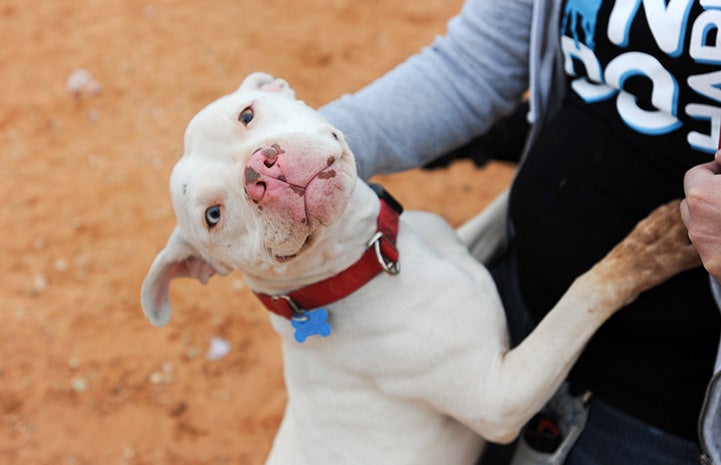
Unlocking a deaf dog’s potential
Ludwig came to Best Friends through local animal control after losing his home when his intense “stranger danger” caused him to bite someone. Even after arriving at the Sanctuary, it was difficult for him to meet new people. Introductions had to be done slowly, and making friends was a long process. Although Ludwig was happy at the Sanctuary, things got even better the day he met Dogtown caregiver Amie Farquhar.
Because both of Amie’s parents are deaf, the first language she learned as a child was ASL. She could see that Ludwig sometimes felt frustrated trying to understand the world around him. She saw, too, that the dog is incredibly smart and that he wanted to learn.
Amie saw an opportunity to help Ludwig. “I love to bridge communication gaps,” she says. “This was the perfect opportunity to bring ASL to him.”
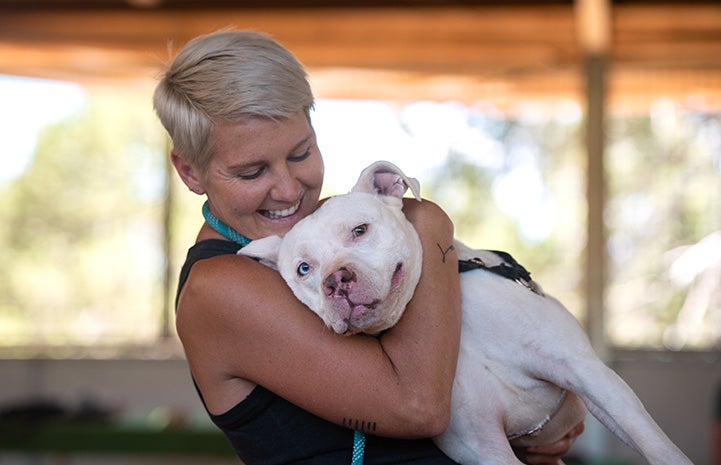
Hand signals for dogs who are deaf
Training a deaf dog isn’t a new thing at the Sanctuary. For years, Best Friends behavior consultants and caregivers have used dog training hand signals as cues. For example, a caregiver could wave a hand to ask a deaf dog to come closer. When the dog comes, the caregiver gives the thumbs-up sign and hands him a treat. The thumbs-up sign is a visual marker that means the same thing to a deaf dog as a “click” for a hearing dog who’s gone through clicker training.
Since Ludwig had already learned some deaf dog hand signals, he had a good foundation for learning ASL. For example, he seemed to understand that when a person extended a hand with palm up in front of him, that meant “sit.” And he knew that thumbs-up followed by a treat meant that he’d done something well. He was all primed to start learning ASL.
Why teach a dog ASL instead of using basic hand gestures for dog training? Amie says it’s because ASL is a universal way to communicate with any deaf individual. “And it’s something everyone can use,” she says. “There’s no need to find common hand signals for dogs, because they already exist. We can utilize them more, and we should. As soon as I met Ludwig, it became my goal to teach him sign language.”
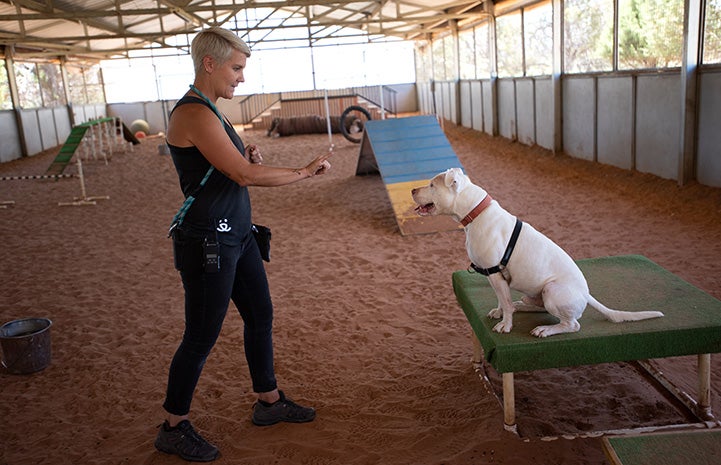
Simple sign language for dogs
Before Ludwig’s first ASL training session, Amie thought carefully about the signs she wanted to teach him and how she might go about it. Some common cues — “lie down” being one of them — required two hands to sign. But Amie thought it might be easier for Ludwig if the sign was as simple as possible and she could hold the treat in one hand and give the sign with the other.
Amie and her mother brainstormed about how to teach a dog hand signals. Although they modified some signs so they could be given with one hand, they stayed as true as possible to real ASL signs. Amie consulted with Best Friends behavior consultant Rebecca Woodruff, who helped her through the process of teaching the signs to Ludwig and later helped her apply those signs to other types of training.
How to teach a deaf dog a new sign
Teaching Ludwig a new sign is the same as teaching a dog any verbal or visual training cue. Here are some easy steps to follow in teaching a new cue to a deaf dog:
- Make sure you have some delicious treats handy and that you’ve chosen how you’ll “mark” the behavior you want to teach. Visual markers (such as a thumbs-up or a light) or tactile markers (a touch, a leash movement or vibrating collar) work well.
- Get the dog to do the desired behavior through capturing, luring or shaping.
- Mark the behavior you teach by using your visual or tactile marker, and then immediately reward the dog with a treat.
- Make sure the dog will do the behavior reliably (and that, in turn, you will reliably provide the reward).
- Start adding in the cue (sign) just before the dog does the behavior.
- Practice to make it perfect. After the cue has been paired with the behavior many times, the dog will understand that you expect the behavior in response to that cue.
Since his first lesson, Ludwig has learned some very useful sign language commands. He knows sit, down, come, touch and stay. He can also respond to some ridiculously adorable signs. He’s learning how to “hug” by reaching up and putting his paws gently on Amie when she crosses her arms in front of her chest. He knows how to wave back when someone waves to him, too.
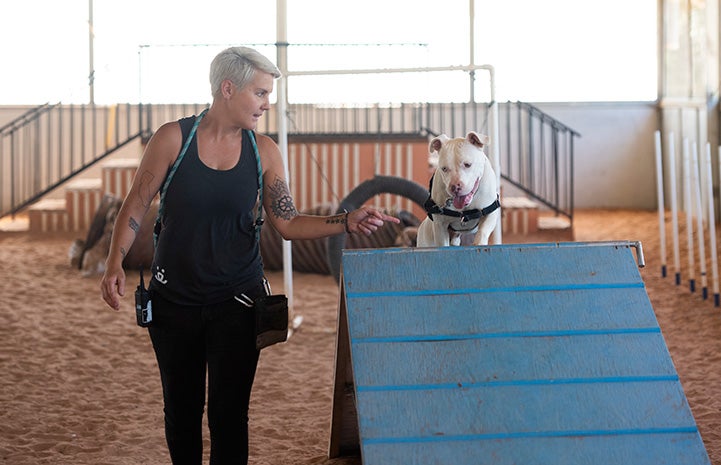
American Sign Language for dog agility
Beyond giving Ludwig a new and clear way to understand and respond to these important and cute training cues, ASL has opened the door to a whole new world for him. He can now do training on Dogtown’s agility course.
Agility is a fantastic way to help dogs facing a variety of challenges. It can also help dogs like Ludwig who struggle meeting new people. It also helps build solid, trusting relationships between dogs and their handlers. Best of all, it’s exciting, fun and rewarding for the dogs.
Learn how agility training helps dogs
So far, Ludwig knows the ASL signs for four agility obstacles he’s been working on, including “table.” When Amie holds her right forearm above her left (with both forearms parallel to the front of her body), Ludwig leaps onto a small platform. Here, he can practice other cues, like sit, down and stay, plus prepare for obstacles such as the dog walk (a raised walkway for which Amie uses the “walk” sign), the bar and the tunnel.
Amie modified the signs for two more obstacles — the A-frame and the tire — to make them easier for Ludwig. For the A-frame, she tents the fingers of both hands into the shape of the letter A, and for the tire she draws a circle in the air with her pointer fingers. This makes sense, she says, because ASL is a very visual and contextual language, so the signs can look exactly like what they mean.
How ASL changed a dog’s life
Since Ludwig began learning ASL, a lot more things are making sense and falling into place. It not only makes his training easier and more fun, but it helps him in other areas of life.
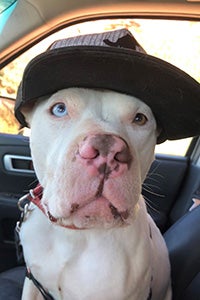 “In addition to mental exercise (which is super important for any dog’s well-being), training sessions provide a structured and predictable environment for Ludwig, so he knows what to expect,” says Rebecca. “Since we use positive relationship-based training, he can expect to get tasty snacks and also feel safe because his boundaries are respected. This all amounts to a sense of trust with the people around him.
“In addition to mental exercise (which is super important for any dog’s well-being), training sessions provide a structured and predictable environment for Ludwig, so he knows what to expect,” says Rebecca. “Since we use positive relationship-based training, he can expect to get tasty snacks and also feel safe because his boundaries are respected. This all amounts to a sense of trust with the people around him.
“In addition, because we’ve taught him new behaviors, it gives him something to do with a new friend. When a new person comes into the picture and they speak this common language (ASL) with him, it can help put him at ease. He knows what’s expected of him, and he’ll know that the new person will also be predictable and kind.”
Amie agrees. “I feel like he's improved so much since he's had this to focus on,” she says. “He can communicate and channel his energy. He has a job now. It’s made him calmer and able to meet people much easier.”
ASL for deaf dogs everywhere
Ludwig’s transformation has enormous personal significance for Amie. “Sharing this with Ludwig has been amazing,” she says. “We’ve really bonded over this experience. It’s beautiful for me to see a deaf dog who was once really frustrated come out of his shell through ASL. Helping to make his life at the Sanctuary better has been so special to me.”
Ludwig still has his challenges, but they no longer rule his life. His horizons have expanded and he’s much happier. He’s also a great example of how ASL can help deaf dogs be more successful and live their best lives. “I’m on a campaign to promote ASL for deaf dogs everywhere,” says Amie.
Help more animals get a second chance at the good life
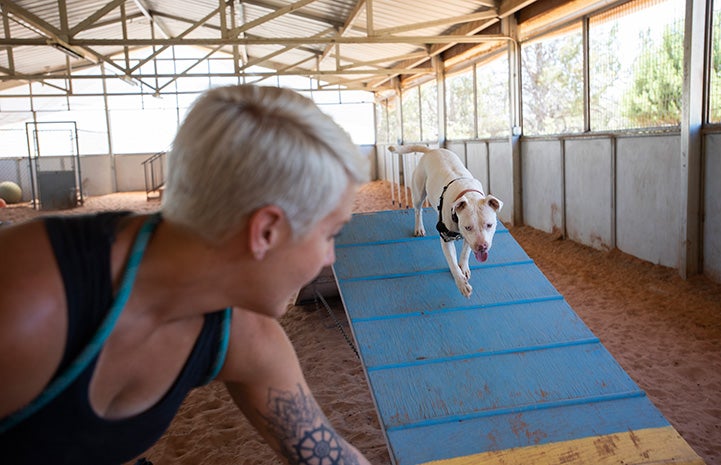
Photos by Molly Wald